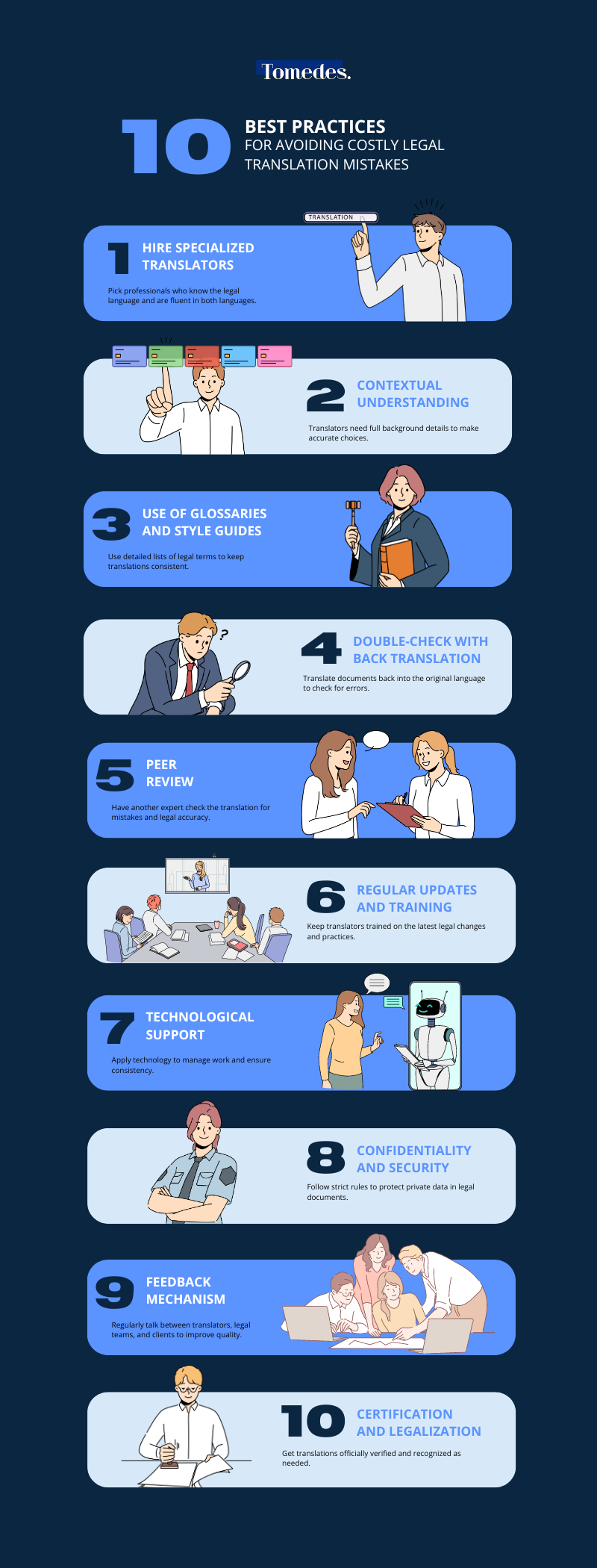Translate 100,000 words for free at MachineTranslation.com by Tomedes
Avoid Costly Legal Translation Errors: Your Step-by-Step Guide
Dealing with legal translation can be tricky. If you're a lawyer, paralegal, or someone in business working with international contracts, knowing how to avoid translation mistakes can save you a lot of time and money.
Let's look at how you can avoid these issues and make sure your documents are accurate and legally compliant.
Understanding legal translation
Legal document translation is far more intricate than merely converting languages. It demands an accurate interpretation of complex legal concepts across varying legal systems. This is crucial as simple word-for-word translations can lead to significant translation errors and mistranslations, especially when the legal frameworks differ markedly between the source and target languages.
For instance, consider the term "public liability." If translated incorrectly, it could lead to a grave translation error, altering the entire legal exposure of the parties involved. Such mistranslations can stem from poor translation practices where legal terms are handled incorrectly. This highlights why legal translation is not just about language proficiency but also about a deep understanding of the nuanced legal concepts that govern different systems.
Read more: Legal Translation: Exploring Its Importance and Diverse Uses
Qualifications of legal translators
The qualifications of certified translators are crucial for preventing translation errors and ensuring document accuracy. Effective translators need a deep understanding of both the languages and the legal systems involved in translation. This dual expertise is vital because many legal terms lack direct equivalents in other languages, leading to potential mistranslations.
Therefore, it is essential to employ legal translators who possess extensive judicial knowledge and translation experience. This is not just a precaution but a necessity to avoid the severe repercussions of incorrect translations. Understanding these complexities helps protect your documents and maintain their legal validity across different legal systems.
Common legal translation errors and how to avoid them
Here are a few common mistranslations to be aware of and avoid when translating legal documents:
Literal Translation: Translating legal terms and phrases word-for-word without considering their legal context can lead to significant errors. For example, phrases like "force majeure" have specific legal implications that go beyond their literal meaning, and misinterpreting them can alter the document’s intent.
Misinterpretation of Legal Terms: Legal terms often have precise meanings that vary between jurisdictions. A failure to accurately convey these meanings can result in incorrect or misleading translations, potentially leading to legal disputes.
Cultural Misunderstandings: Legal documents often reflect the cultural and societal norms of a particular region. Overlooking these cultural nuances can affect the interpretation of legal terms and lead to misunderstandings. For instance, contract clauses that are standard in one country may be unfamiliar or even unacceptable in another.
Inconsistency in Terminology: Using inconsistent terms across multiple documents or within the same document can create confusion and ambiguity. Consistency is crucial in legal translation to ensure that the same legal concepts are referred to in the same way throughout all documents.
Neglecting Legal System Differences: Legal systems vary significantly from one country to another. Not accounting for these differences when translating legal documents can lead to translations that are legally inaccurate or irrelevant. Translators must be aware of the legal systems in both the source and target languages to ensure the translation is valid and enforceable in the intended jurisdiction.
Read more: How Accurate Translations Helped Law Firms Win Major Litigation Cases
Risks of over-relying on machine translation
Relying on machine translation tools like Google Translate can be tempting, especially when pressed for time. However, these tools often fall short in legal contexts. They are improving, but they're not yet reliable enough for documents where precision is paramount. For example, a machine might translate the term "binding agreement" accurately in a general context but miss the legal nuances necessary for your specific document.
Read more: MTPE for Legal Translation
Review and quality assurance processes
Having a rigorous translation quality assurance process is your best defense against translation mishaps. This involves several layers of checks:
Initial Translation: Performed by a qualified legal translator.
Review: Conducted by another legal expert, preferably with a specialization in the document’s subject matter.
Back-Translation: Translating the document back into the original language by a third translator to check for consistency and accuracy.
Final Review: Ideally by a legal professional fluent in both languages.
This multi-step process helps to ensure that the final document is both legally accurate and linguistically precise.
Best practices for avoiding costly legal translation mistakes
In the realm of legal translation, the margin for error is exceptionally narrow. We interviewed our experienced legal translators to gather these best practices, which are designed to ensure accuracy and prevent costly mistakes:

1. Hire specialized translators
Always choose translators who specialize in legal translations. These professionals are not only fluent in both the source and target languages but also understand legal terminology and concepts specific to the jurisdictions involved. This specialization is crucial for avoiding misinterpretations that could lead to legal repercussions.
2. Contextual understanding
Ensure that translators have access to all necessary background information. This includes details about the legal systems of the countries involved and any specific context surrounding the case or contract. Understanding the broader context helps translators make informed decisions about terminology and phrasing that accurately reflect the intended meaning.
3. Use of glossaries and style guides
Develop and maintain comprehensive glossaries and style guides that include legal terms and their translations, usage notes, and context. These tools are invaluable for maintaining consistency across multiple documents and translations, particularly in large-scale or ongoing legal cases.
4. Double-check with back translation
Employ back translation for critical documents. This process involves translating a document back into the original language by a second translator. Compare the back-translated document with the original to spot potential discrepancies or misunderstandings.
5. Peer review
Implement a peer review system where another legal translator checks the translated document for accuracy and appropriateness. This review should focus not only on language but also on ensuring that the translation meets all legal requirements.
6. Regular updates and training
Keep translators up-to-date with changes in both source and target legal systems. Regular training sessions can help translators stay current with new laws and legal interpretations, which can significantly impact the accuracy of translations.
7. Technological support
Utilize translation management systems (TMS) and computer-assisted translation (CAT) tools where appropriate. These technologies can help manage workflows, maintain translation memories, and ensure consistency across documents. However, always ensure that a qualified translator reviews any machine-assisted translations for accuracy.
8. Confidentiality and security
Maintain strict confidentiality and security protocols to protect sensitive information. Legal documents often contain private data that must be safeguarded throughout the translation process. Ensure that all translators and technical systems comply with relevant data protection regulations.
9. Feedback mechanism
Establish a clear feedback mechanism between the translators, legal team, and clients. Regular feedback helps identify recurring issues and areas for improvement, enhancing the quality of future translations.
10. Certification and legalization
For documents that will be used in legal proceedings or need official recognition, ensure that translations are properly certified and, if necessary, legalized according to the requirements of the country where they will be used.
Conclusion
Legal translation is a field where stakes are high and errors can be costly. By employing qualified professionals, utilizing rigorous review processes, and understanding the importance of cultural nuances, you can mitigate the risks associated with legal document translation. Remember, in the realm of legal translation, precision is not just a goal—it’s a requirement.
By following these steps, you can protect yourself and your organization from the risks of poor translation and ensure your legal documents maintain their intent and legality in any language.
To guarantee accuracy and professionalism in your legal translations, partner with Tomedes. Our expert translators specialize in legal contexts and understand the nuances of various legal systems, ensuring precise and reliable results. Contact us today to safeguard your legal interests with top-notch translation services.

By Clarriza Heruela
Clarriza Mae Heruela graduated from the University of the Philippines Mindanao with a Bachelor of Arts degree in English, majoring in Creative Writing. Her experience from growing up in a multilingually diverse household has influenced her career and writing style. She is still exploring her writing path and is always on the lookout for interesting topics that pique her interest.
Share:
GET IN TOUCH
Need expert language assistance? Inquire now
Try free AI tools to streamline transcription, translation, analysis, and more.
Use Free Tools
Post your Comment